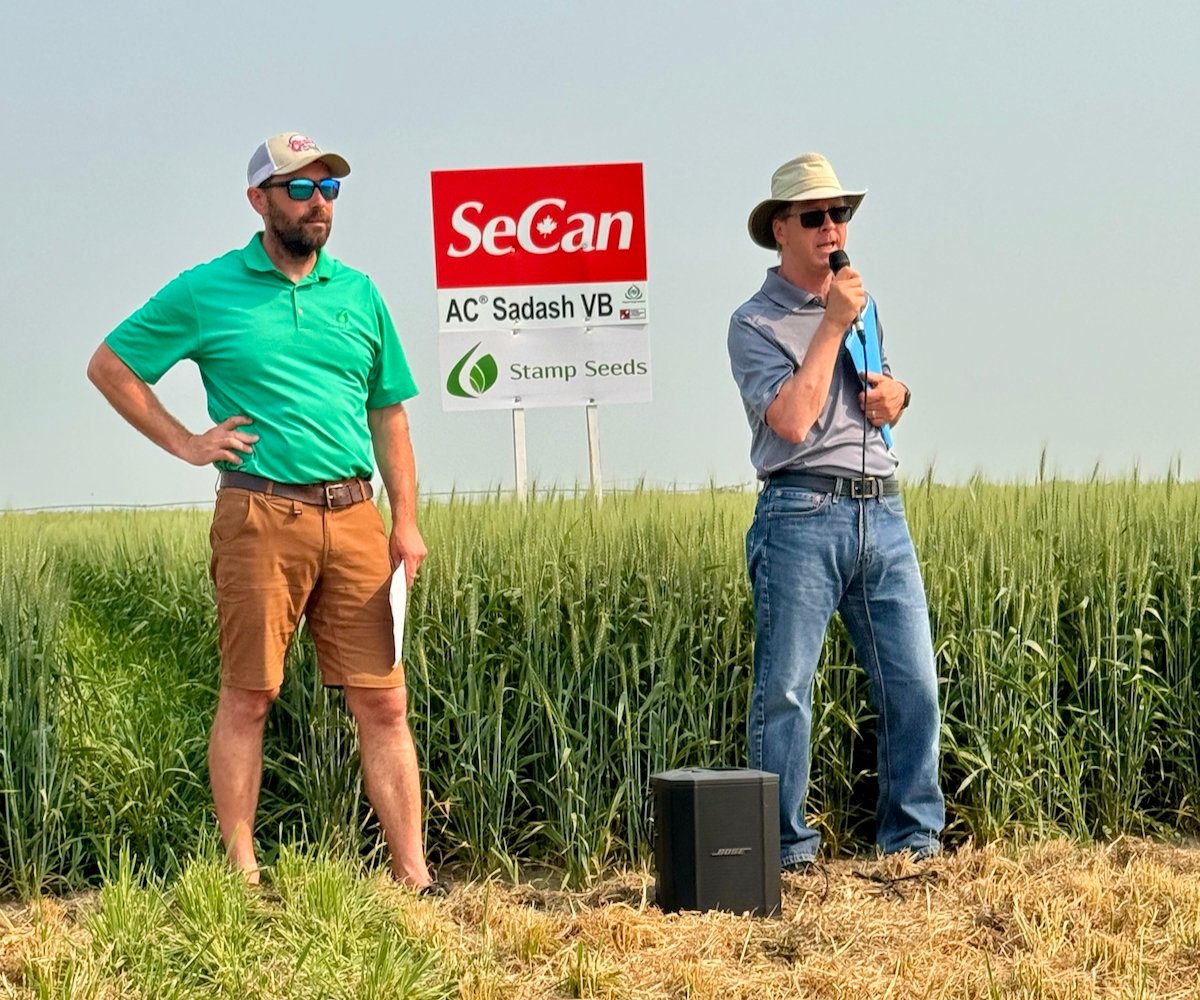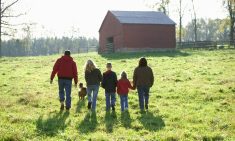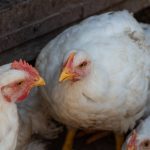“Farming is an important, low-margin business that has got to be fine-tuned like a guitar to make beautiful music.”
This insight comes from Kim McConnell, someone who knows about business success — and how to make that beautiful music. After a long career in the agriculture industry, the former founder of AdFarm is still mentoring up-and-coming young executives in agriculture and he knows what it takes to succeed in the industry.
“We are in an industry with a future. Just look at how many people we have got to feed, and what we do in the world,” McConnell says. “To do that, we need young people who are sharp and smart, innovative and creative. They need to be entrepreneurs. They have to be able to analyze the opportunities, the challenges, and to take on and mitigate risk. That’s the entrepreneurial component of all this.
Read Also

Are you ready for farm succession?
What motivates some farmers to make a succession plan while others don’t seem worried.
“Your production, marketing, financial and management skills have to be sharp. If you are going to run a viable business, you are going to have to be on top of all those things and that takes good business skills.”
Business basics don’t change
Today’s young farmers are focusing a lot more on business skills than previous generations. They know these skills will help their farms be successful not just in their core operations but also help them identify opportunities as they arise.
And the basic principles that make a farm successful are the same for any business.
It comes down to four factors: producing a good product, marketing that product, understanding financials, and sound management. Farmers need to be in control of all these things. That’s not to say they must be an expert in every area, but they should be able to recognize when extra help is required in the form of employees or advisors.
“Nothing’s changed in terms of farmers needing farm business management practices and those practices, in their essence, haven’t changed,” says Heather Watson, executive director of Farm Management Canada. “Of course, new skills are required for farming, such as data literacy, but farm managers don’t need to take it all on themselves. They need to figure out the skills required to farm and be resourceful in building the capacity of the farm by finding others with those skills and hire them in or contract the services out.”
Where you make your money
Although marketing hasn’t traditionally been a strong suit for many farmers, it’s something they should understand even if they are selling into bulk commodity markets.
“You have to be able to market the product and be sure that you are selling it at the price you need to make a profit,” McConnell says.
Hand in hand with marketing is risk management, another skill that today’s ag entrepreneurs are eager to learn about.
“As an example, people are interested in understanding how the futures market work,” says Larry Martin, who has been an instructor for the Canadian Total Excellence in Agricultural Management (CTEAM) program for many years. “There is definitely more interest in risk management today.”
Arguably, the most important skill — and the most challenging — is financial and strategic management. The profitability and sustainability of the farm hinges on these fundamental elements.
“All the successful businesspeople I know definitely know their numbers,” McConnell says. “They have specific data on all aspects of their operation. They know their costs per acre, per animal, etc. They know their cost of production to the minute detail. They have data at their fingertips that they can use to make the right decisions and better decisions.”
“A lot more people are appreciating why they need to understand their finances better,” says Martin. “Some people who committed to land or equipment when crop prices were high are in trouble now that banks are becoming more conservative in terms of their management, so people are realizing it’s not a bad idea to understand financial ratios and what they mean.”
Start with a plan
Even though a strategic approach is more important than ever, only one in five Canadian farmers approach farm management strategically.
“This has got to change if we are going to sustain Canada’s farm sector,” says Watson.
“It’s important to take a strategic approach to farming, grounded in a clear vision of success and a road map to success. That includes understanding the business landscape, the risks and opportunities out there, and understanding and building the internal capacity to succeed, while leveraging external resources to expand capacity.”
And it all begins with a plan.
“My definition of strategic management is you start with a plan, then you use all sorts of data to measure whether your assumptions are correct, and your performance is as you expected it to be,” says Martin. “Make sure you are ready to pivot whenever the data tells you that things have changed. Those are the parts of strategic management that allow people to make informed decisions so that they can go in the right direction.”
“Each farmer is going to have to study their situation, where they live and what they have,” McConnell says. “For some, the opportunity will be to get bigger, for some it will be to diversify into another area or into different crops. Every situation is different. Everybody’s got to do a sufficient level of strategic thinking to determine what success is going to look like for them, and how they are going to go about doing it.”
The experience factor
Greg and Sarah Stamp of Enchant, Alta., were voted Alberta’s 2023 Outstanding Young Farmers and went on to win the National OYF title that year. When they came back to the Stamp family farm in 2006, Greg started out as an employee. His intention was to stay five years to help rebuild the seed side of the business with his parents, Richard and Marian, so they developed a plan from day one.
“For entrepreneurs, writing down a plan with timelines, business and personal goals, and having communication amongst the people you’re working with, is so critical,” Stamp says. “Having that all written down so you can reference it, adjust it and know exactly where everyone else is at was something we did from the start.
“Our budgets, plans and goals allow us to understand where the money is being made, where it’s going, and how things are secured, so we can have clear communication with our bankers.”
Five years turned into 10 for the Stamps. They weren’t easy years, but eventually Stamp and his two brothers, Nathan and Matthew, began to see the business grow exponentially and start to achieve the vision they had outlined in their planning process.
Today, the 8,500-acre farm produces pedigree wheat, barley, faba bean, pea, lentil, flax, hybrid rye, mustard and hybrid canola seed with the help of 20 full-time and nine seasonal employees. Greg is the seed sales manager, Nathan manages the farm’s day-to-day operations, and Matthew runs business operations and on-farm construction projects. They have also hired a CFO.

Stamp knows the importance of soft skills, such as teamwork, active listening, problem solving, conflict resolution and critical thinking. “It’s how you talk to people, how you plan with people, how you make someone feel when you talk to them,” he says. “Even talking on a phone to someone, or how you approach someone is a skill that is rare but is so critical in agriculture because it’s a relationship business.”
These soft skills can be taught by a parent or a mentor, instructor or professor, but are challenging to implement. Communications, teambuilding and adaptability, for example, are primarily shaped and developed through personal attributes and values, and are embedded in the experiences, relationships and perspectives that people acquire over a lifetime.
When it comes to gaining experience and perspective it’s a policy on the Stamp farm that family members have to get further education after high school. They also must work elsewhere for two years before they come back to the farm, because they value life experience as much as they do education — and because they know it ultimately provides benefits not only to the person but also the farm.
“It’s got to be two years away working for someone else so that you learn what working in the real world is like, and also to explore other options,” Stamp says. “If and when they do come back, what value are they going to bring back to the business? What are they going to take care of? What are their goals? I want to hear all that from someone who’s joining as an employee and potentially an owner one day. What are you going to bring back to the business?”
Communication is key
Farm Management Canada, which has been committed to the adoption of business management practices on farms for over 30 years, notes that the biggest stumbling block is readiness to commit. Often, when farmers are asked why they aren’t investing in business skills and practices, they admit that they can’t get other members of the family or farm team on board.
“The key ingredient that’s missing is the willingness and commitment to develop the skills to have the tough conversations, to make a concerted, consistent effort to talk about the things that need to be talked about,” Watson says. “To understand the resistance and learn how to move through it, or in some cases, move on. This is where I think we, as an industry and young ag entrepreneurs, need to focus development. Call it leadership, call it whatever you want. The fact is, we need to learn to communicate more effectively and build better relationships with others.”
It’s not an easy thing to do, but it is essential. For the Stamp family, rapid growth, more staff, more procedures, and an expanded land base and facilities means they’ve had to renew their focus on communicating effectively with each other and their growing employee base.
“It allows you to do a better job when everyone’s got their different areas of expertise and responsibilities, but it also comes back to how you communicate amongst the group, otherwise you end up in silos in the business,” Stamp says. “It’s a big challenge for everyone, us included.”
The Stamps tackle the issue by holding in-depth quarterly management meetings to make sure everyone stays on track with the plan. They also hold informal weekly staff meetings to discuss day-to-day operational and staffing needs.
The human factor
As farms get larger and more complex and need more people to run them, more farm owners and operators are seeking human resource management training.
“When we ask people what they want to learn, HR is always at the top of the list, whether it’s from the perspective of managing family or employees,” says Martin, who is launching a streamlined sequel to the CTEAM program called Strategic Agribusiness Management.
“It’s a bigger problem for farmers in general to manage family HR issues because of the typical pattern of turning over the operation to family members. If you are turning over something that is generating $150,000 a year that’s one thing, but if you are turning over something that is generating $8 million you have a bigger question about whether the next generation is ready.”
The Stamps agree that human resources have become a bigger focus for them as the business grows.
“The HR side has become much more critical,” Stamp says. “You need to know the people you’re working with, and what their goals are. For example, how much time do they have in the business before they want to start slowing down? How does that look later? And what is their job? I always emphasize that being an owner, a manager or an employee can be separate things because the goals and your role in the business will be different as an owner than as an employee. That’s something I didn’t realize as much early on.”

Successful entrepreneurs also understand that any investment they make in ongoing skills development, training and networking, whether formal or informal, can help make them better managers and decision makers and consequently provide a good financial return to their business.
What’s more interesting still are the less tangible benefits these skills and practices can bring to farmers’ lives and families, which strike at the very heart of how farmers today define success.
In a recent survey, farmers were asked to identify the characteristics of a successful farm. Farmers ranked maximized efficiency and maximized profits the highest (63 per cent each), followed by work-life balance (56 per cent) and harmony in the family and farm team (55 per cent). In fifth place, at 49 per cent, was maximized production.
“We have never seen work-life balance and family and farm team harmony crack the top ten priorities, let alone the top five,” Watson says.
When the data is sorted by age demographics it becomes clear that work-life balance ranked higher for farmers under 40 years of age (60 per cent). Farmers aged between 40 and 60 still ranked maximized profits (69 per cent) and maximized efficiency (64 per cent) the highest, while harmony in the family and farm team ranked highest for farmers over 60 (60 per cent). When asked their top goals for the next three years “balancing work, life and family needs” topped the list.
With these results it is hardly surprising that farmers who do invest in building their strategic management and business skills are defining value beyond the balance sheet.
“This data tells a story, a story about the evolution of farming and what it means to be a successful farmer,” Watson says. “These findings suggest that today’s agricultural entrepreneurs must embrace a holistic approach to farm management, integrating both economic and personal well-being into their definition of success.
“It would seem that if maximizing efficiency, profit, work-life balance, harmony in the family and farm team, and production are the keys to long-term success, we ought to be focusing on building those skills.”
Martin also surveyed CTEAM alumni from 10 years ago to find out what difference the program has made to their business.
“Not surprisingly, they said that it was an investment that gave them well over 100 per cent return from a monetary perspective,” Martin says. “But they also said they had better relationships with their families, more self-confidence and better mental health. We didn’t do anything to elicit those responses; they took upon it upon themselves to tell us that. It was heartwarming to get that result back.”
Resources:
- The Canadian Agricultural Human Resource Council (CAHRC) has many resources on its website at cahrc-ccrha.ca and offers an online Ag HR Management Program and a Women in Essential Agricultural Leadership Skills Program. It also offers an AgriHR Toolkit, including checklists and customizable templates for job descriptions and HR plans, for example, designed to help farm owners and managers create an effective HR management strategy for their operation.
- For the past several years, Farm Management Canada (agriresources.ca) has been working in partnership with LeaderShift to offer the National Farm Leadership Program. This year they’ve launched a new program called InSight to help farmers whet their appetite for developing their leadership effectiveness by understanding the fundamentals of how people think, and how this influences behaviour and results.
















